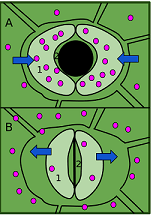Nutrition function in plants
Photosynthesis
Plants are autotrophic, and need to capture inorganic matter from the environment, through roots and leaves, to make their own organic matter.
Plants take water and dissolved mineral salts from the soil through cells that are in the root hairs, at the ends of the root. This mixture of water and mineral salts that the plant absorbs is called crude sap. The crude sap circulates towards the leaves through a set of conductive vessels called xylem.
In addition, plants capture carbon dioxide from the air that enters the leaves through the stomata, pores on the underside of the leaves. The stomata are formed by two occlusive cells that regulate the passage of gases through the hole between them. In the leaves, photosynthesis and gas exchange with the atmosphere take place.
 Lmackay2013 [CC BY-SA 3.0], via Wikimedia Commons
Lmackay2013 [CC BY-SA 3.0], via Wikimedia Commons
Photosynthesis is the process by which plants manufacture organic matter from water and mineral salts, which they take in through the roots, and carbon dioxide that enters through the leaves (inorganic matter), using light energy from the sun, and releasing O2 as scrap.
To transform inorganic matter into organic matter, they need energy from sunlight. Autotrophic photosynthetic organisms capture energy through chlorophyll, a green pigment found in the chloroplasts of plant cells that use energy from sunlight. to transform inorganic matter (raw sap) into organic matter (processed sap). They obtain simple carbohydrates , such as glucose, and release oxygen into the atmosphere that living beings can use to breathe. The carbohydrates produced, together with water, form theelaborated sap that goes to all parts of the plant through the vessels that form the phloem.
water + mineral salts + CO2 + sunlight → organic matter + O2
The organic matter obtained in photosynthesis is used to create new structures and to obtain energy through cellular respiration.